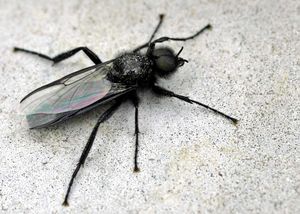March fly
| March fly | ||||||||||||
|---|---|---|---|---|---|---|---|---|---|---|---|---|

March fly ( Bibio marci ), male |
||||||||||||
| Systematics | ||||||||||||
|
||||||||||||
| Scientific name | ||||||||||||
| Bibio marci | ||||||||||||
| Linnaeus , 1758 |
The March Fly ( Bibio marci ), also known as March Hair mosquito , Markus fly or Markus Hair mosquito called, is the most common, occurring mostly in swarms kind from the family of bibionidae (Bibionidae) and is one of the Diptera (Diptera). The name Markusfliege stems from the fact that they swarm out very often around St. Mark's Day , April 25th.
features
March flies are jet black glossy mosquitoes (Nematocera) that are more like flies (Brachycera). For a mosquito, the nine-part feelers are very short, the buttons have five-part. March flies are about eight to eleven millimeters long, making them the largest hair gnats in Europe . The females and the rough-haired males can be distinguished very well by the eyes, the males have very large, hemispherical eyes, while the females only have small, sideways eyes and a smaller head. The secondary eyes are also very easy to see. The females have black wings and those of the males seem more whitish. The front rails are drawn out like thorns. Wings and legs are rather short, so they look stocky and relatively robust. In flight, the males hang their legs, which is typical of mosquitoes, so they appear quite clumsy.
distribution
March flies are from Europe to Central Asia common. Often you see them hanging in large swarms on bushes or small plants. They prefer open landscapes near water.
nutrition
The adult March flies feed on various sap and nectar and pollinate the flowers. In the larval stage, they feed on rotting parts of plants ( saprophagous ) in the soil and are therefore quite useful. However, it sometimes also happens that they eat living root stocks, leaves or algae ( rhizophag , phyllophagous ). However, March flies are omnivorous because they also feed on excrement ( coprophagous ) and eat various small animals ( zoophag ). The disintegration of their ball of manure very quickly results in fine waste . Many bacteria live in the intestinal tract , and they also find good living conditions in the feces and decompose it together with lower fungi and protozoa .
Reproduction
The March flies dance together in the air to find a pair. Mating also begins in the air during flight and continues on the ground or in low bushes. After mating, the female lays around 100 eggs in the loose soil or in fertilizer and soon afterwards the March flies die. After the new generation hatches in 35 to 40 days, the larvae develop relatively gregariously in the soil, in the fertilizer or under leaves and overwinter. Because of their sociability, they fly out in swarms at the end of March to May.
parasitology
March flies are often attacked by Borophaga incrassata , a solitary endoparasite . The parasite eggs are introduced into the larvae or pupae of their victims. At first it lives in the head of its host, which is therefore deformed. After the head has been hollowed out, the parasite larvae migrate through the body of the March fly in the abdomen (abdomen), where they pupate.


